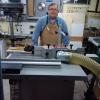Buying my first table saw next week.
Also trying to decide whether or not I should get a router table for the shop. Also a first.
If so, do y'all recommend adding a router table extension as part of the table saw? Or should the router table be a separate, stand-alone unit?
Hoping to start building furniture and trying to acquire the shop tools needed to do so.
Thanks to all that respond.




 Reply With Quote
Reply With Quote






